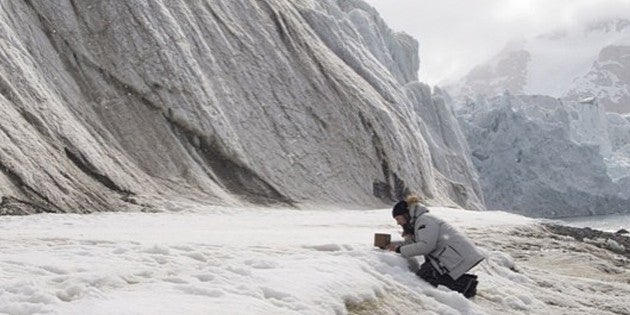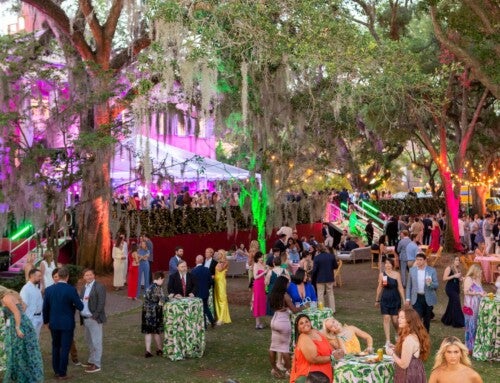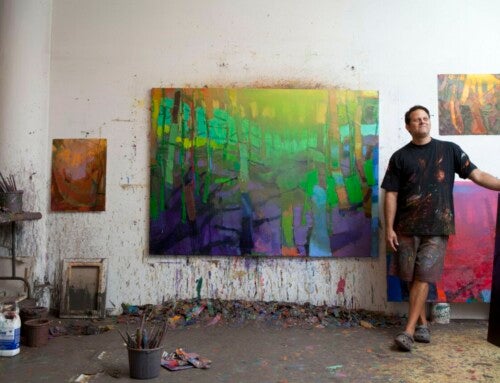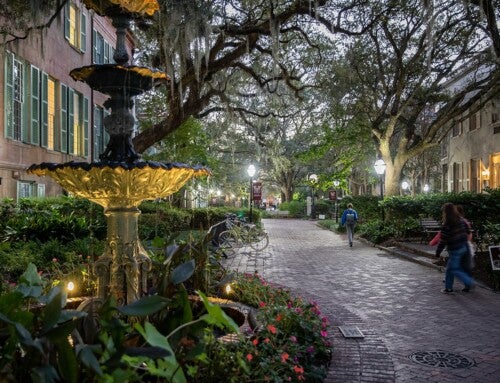Great artists constantly push their boundaries and test the limits. If there’s an edge, they walk along it, and oftentimes just throw themselves over.
Vanessa Albury ’01 does all that. Last summer, however, she went one step further: During a trip to the Arctic Circle, Albury’s artwork was edgy enough it required armed guards and the establishment of a protective perimeter.

Vanessa Albury called the tall ship Antigua her home for three weeks as she explored the Arctic Circle in 2014. (All images courtesy of the artist)
It might seem extreme, but Albury and 26 other artists were members of the 2014 Arctic Circle residency program, which sends artists, writers, teachers and scientists far north to Svalbard, Norway, allowing them exploration of the Arctic Circle. For nearly three weeks the artists and 10 crew members lived aboard the 152-foot tall ship Antigua, sailing frigid waters and making excursions to glaciers deep in the heart of polar bear country.
The polar bears necessitated that rifle-toting guards accompany the artists when they went ashore. Always, says Albury, the guards formed a large triangle that surrounded the artists. If a polar bear was spotted, the group immediately returned to ship, wary of the bears making sneak attacks, possibly by swimming covertly toward an artist.
“They are fierce, furious and fearless, which is a deadly combination,” says Albury, a photo-and process-based artist who lives in New York City. “They’re not afraid of anything. The world is their oyster.”
Another danger: the glaciers themselves. All artists were required to keep at least 200 meters from any glacier walls in case they suddenly calved and came crashing down – something Albury witnessed a number of times. This restriction presented some problems for Albury, who had hoped to project images on the glacier walls as part of an art project.
“Like a tree hugger, I wanted to be a glacier hugger,” she says. “That wasn’t a safe option.”
So instead she took photographs of her environs, taking daily snapshots of the sea splashing against the 13-inch porthole in her cabin, especially when the Antigua was navigating rough waters.
“The duality of being underwater but being in the cabin hit me,” Albury says of her porthole project. “It was just a mesmerizing visual. Very visceral.”
Other times she ventured off the boat to photograph glaciers and the sea using a pinhole camera, creating moody, otherworldly images devoid of color.
She snapped a great picture, too, of a red bearded seal atop a floating ice floe. The seal was so close Albury could have touched him.
Each day on the trip, says Albury, featured the profound. Discussions among the artists on board often involved an examination of their precarious existence in such an unforgiving area of the Earth.
“(The Arctic Circle is) one of the most treacherous places, as isolated as can be, yet (there’s) still this connection to people,” says Albury. “It was really nice.”
One unforgettable moment of the trip occurred when Albury and her companions went skinny-dipping off a beach covered with big chunks of sea ice. Albury ran into the sea screaming, trading the 32-degree air temperature for the frigid water. It was indeed cold, confirms Albury.
“Every step into the water my body said, ‘What are you doing?’” she says. “But afterwards there was this amazing relaxation when bundled up. I felt this deep satisfaction in my body.”
This summer Albury will head to Harbor Island in the Bahamas, where she plans to experiment with her beloved Holga camera by placing it in plastic bags and taking underwater photos. She will also return to Norway, where she plans to use a grant from the Foundation for Contemporary Arts to make a camera obscura using natural materials found along a river delta in the Nordland region for the Kejerringøy Land Art Biennale.
That’s not all. Albury has been selected as the artist in residence at the CEPA Gallery in Buffalo for the rest of 2015. For Albury, who entered the College as a physics major before switching her majors to studio art and French, it all promises to be a blast.
“The process of photography is like being in a science lab. It’s curiosity and exploration with an unknown outcome, but a process I trust because I know my materials and tools, and my process has served me thus far,” says Albury. “Picking the right tool for the job involves understanding how that tool functions and how it images the reality and experience I’m in and I seek to share. I really enjoy the discoveries.”







